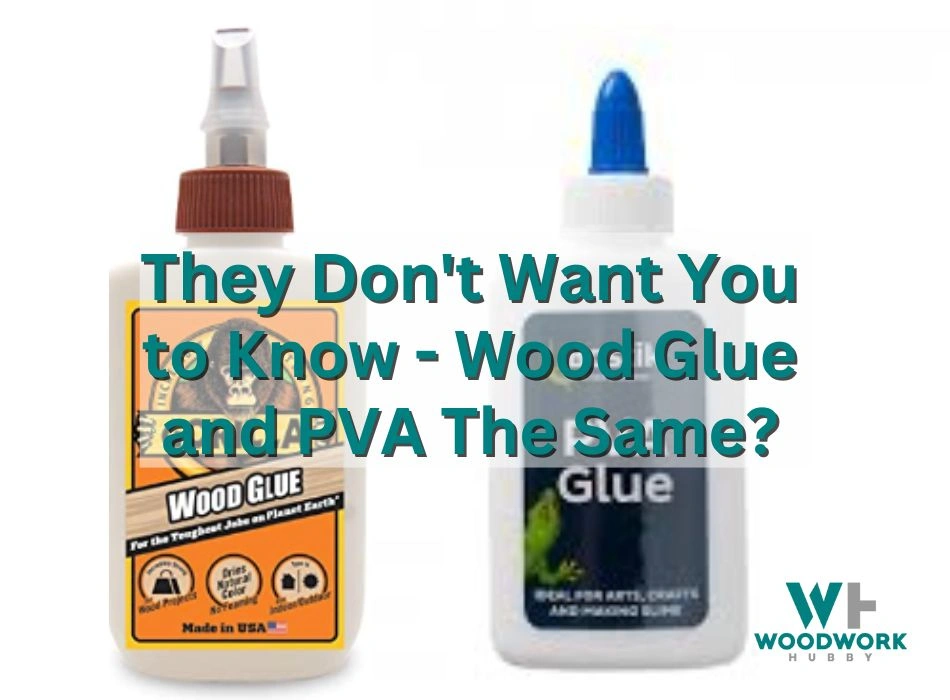Are wood glue and PVA the same? It’s a commonly asked question by both DIY enthusiasts and hobbyist woodworkers alike. Just like you, I’ve found myself standing in the adhesive aisle, wondering what makes these two substances different.
After much research, it turns out that they do have differences worth knowing!
While both PVA and wood glue are made from the same synthetic resin, wood glue is a much stronger version of regular PVA. Wood glue also sets quicker than PVA.
Understanding Wood Glue and PVA
Wood glue and PVA (Polyvinyl Acetate) are two types of adhesives commonly used in woodworking projects.
Video on wood glue for veneers
What is Wood Glue?
Wood glue is a type of adhesive specially designed for woodworking tasks. It’s primarily composed of synthetic resin and is known for its impressive shear strength, often creating a bond stronger than the wood itself.
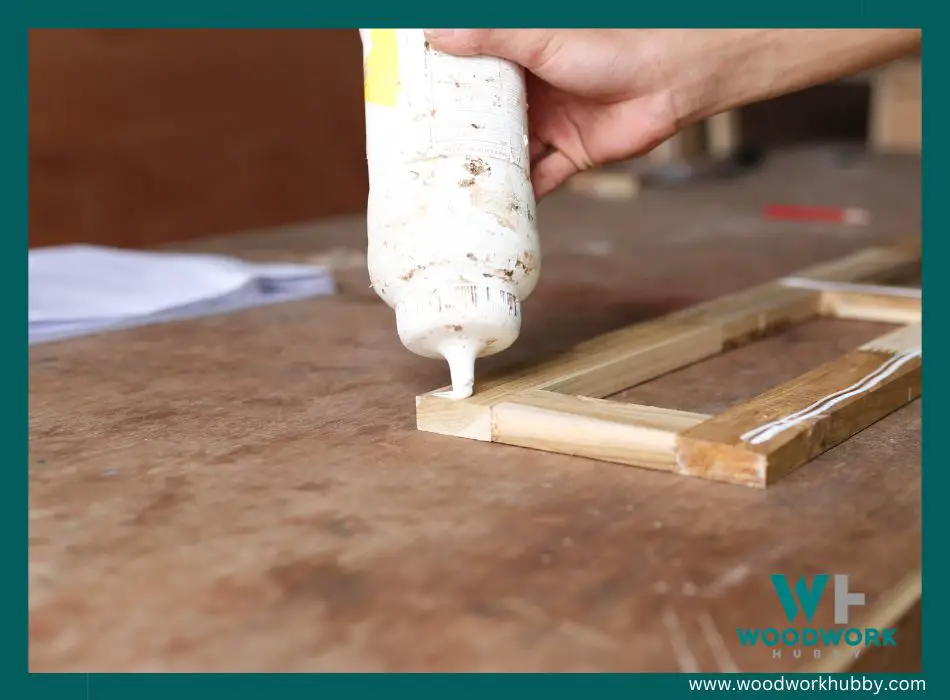
Besides being water-based and resistant to moisture, it stands out due to its nontoxic nature and pH neutrality. Despite appearing similar to craft or school glues, which are also based on polyvinyl acetate (PVA), wood glue offers superior bonding capability that lends longevity and robustness to wooden structures.
What is PVA Glue?
PVA glue, short for Polyvinyl Acetate, is an adhesive commonly found in the toolbox of every woodworking enthusiast. This water-based resin stands as a primary ingredient in wood glue, earning it other names such as carpenter’s glue or simply, wood glue.
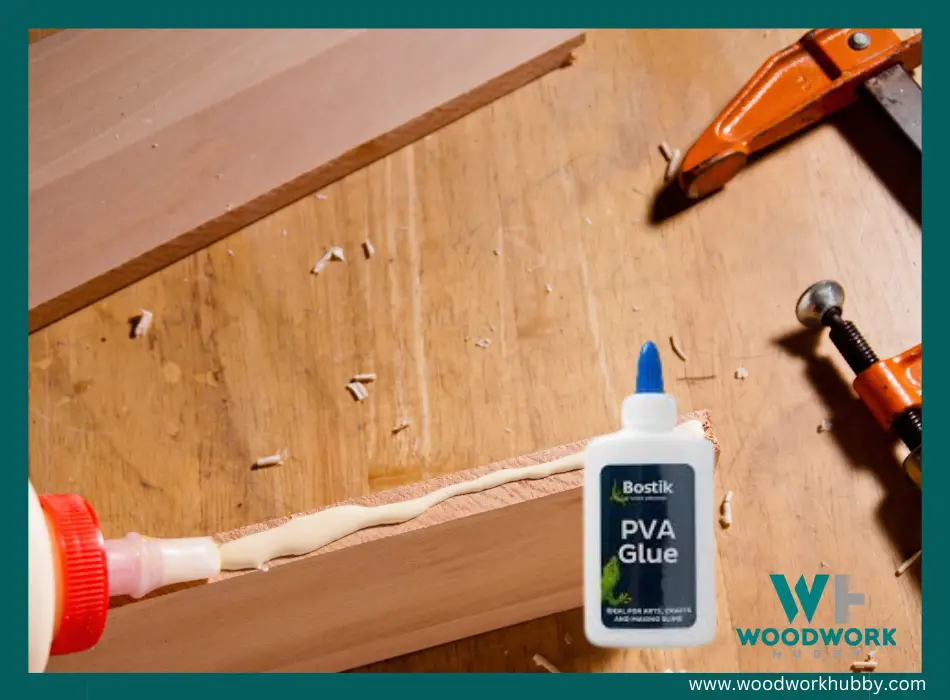
PVA Glue takes the spotlight in various applications because it poses no harm – it’s non-toxic and maintains a pH-neutral composition.
You’ll find this sticky solution to be quite easy to handle. It’s widely available at most hardware and craft stores without burning a hole through your pocket. Its convenience extends beyond affordability though; any mess made with PVA Glue can be easily tidied up with water!
I explained how long to let wood glue dry before sanding in my article. It’s a must-read!
Whether you’re making crafts or building furniture, there seems to be no escaping from the true value that is PVA Glue.
The Difference Between Wood Glue and PVA
Wood glue and PVA glue are definitely not one and the same. Despite both originating from the same synthetic resin, they differ greatly in their properties and applications. Unlike regular PVA, wood glue is crafted to set at a much quicker rate, saving craftsmen precious time on their projects.
This type of adhesive also surpasses its counterpart when it comes to strength – it’s so robust that the bond it creates is typically stronger than the wood itself!
See the article I wrote on why your wood glue won’t dry.
Furthermore, if your project requires sanding or will be exposed to water or heat, you’ll want to grab a bottle of wood glue rather than PVA. It can endure these conditions without losing its powerful grip or degrading over time.
With more resistance against heavy shear forces as well, there’s no denying that wood glue reigns supreme in terms of toughness and versatility!
Types of Wood Glue
There are several types of wood glue available, including polyvinyl acetate (PVA) glue, polyurethane glue, cyanoacrylate glue, epoxy, and hide glue.
Video on the different types of wood glue
Polyvinyl Acetate (PVA) Glue
Polyvinyl Acetate (PVA) glue is the most common type of wood glue. It is a synthetic resin that provides a strong bond for woodworking projects. What sets PVA glue apart from other wood glues is its fast-drying nature and excellent strength.
Titebond 3703 Cross-Linking Polyvinyl Acetate Dark Wood Glue
Once dried, PVA wood glue can be sanded to achieve a smooth finish. Additionally, it offers good water resistance and can withstand heat, making it suitable for various applications in woodworking.
I wrote this informative article showing what the drying time is of gorilla glue.
Polyurethane Glue
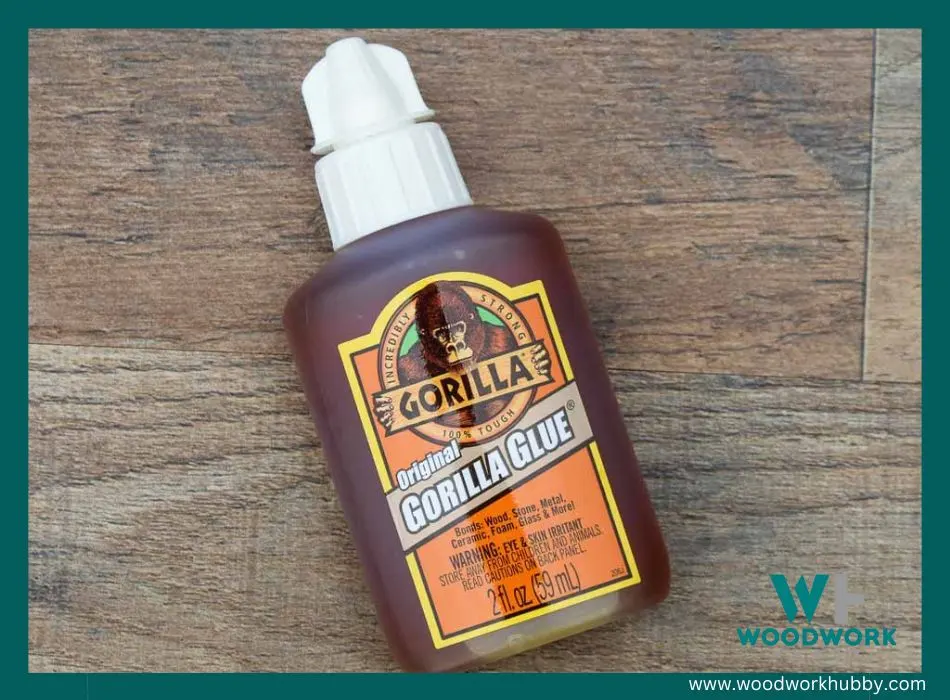
Polyurethane glue is a type of wood adhesive that is different from PVA glue. Unlike PVA glue, which is water-based, polyurethane glue does not rely on moisture to cure. Instead, it undergoes a chemical reaction and expands as it cures, creating a strong bond in loose-fitting joints.
This makes polyurethane glue particularly effective for woodworking projects where there may be gaps or uneven surfaces to join together.
One advantage of polyurethane glue is its versatility. It can be used on both porous and nonporous materials, making it suitable for various bonding applications beyond just woodworking.
Additionally, polyurethane glue excels at connecting end grain joints – the cut ends of wood pieces – which are notoriously difficult to join securely.
Gorilla Original Gorilla Glue, Waterproof Polyurethane Glue
Another benefit of using polyurethane glue is its resistance to moisture and heat. This makes it an ideal choice for outdoor projects or items that may be exposed to moisture over time.
Cyanoacrylate Glue
Cyanoacrylate glue, also known as “super glue,” is a type of adhesive that offers high strength for bonding wood. It is commonly used for small and quick repairs due to its low curing time, which ranges from instant to several minutes.
One important factor to consider when using cyanoacrylate glue is compatibility with other cured wood glues. While it may not work well with most types, it does bond effectively with PVA (polyvinyl acetate) glue, making it a versatile option for woodworking projects.
Additionally, cyanoacrylate glue forms strong bonds with various materials commonly used in woodworking, ensuring reliable and durable results.
Epoxy
Epoxy is a type of wood glue that offers superior strength, durability, and longevity compared to other adhesives. It is highly compatible with wood glue and can be used in combination with even stronger bonds.
When using epoxy, it’s important to remember that it requires a heavier glue line and lighter clamping pressure compared to other adhesives. Many woodworking enthusiasts choose epoxy for its perceived strength and cost-effectiveness.
With its adhesive properties, epoxy is an excellent choice for project-specific needs where long-term bonding is required.
See my article explaining the dry time of Gorilla wood glue. It might surprise you.
Hide Glue
Hide glue is a specialty wood adhesive that offers unique advantages for woodworking projects. Unlike other types of wood glue, hide glue does not contain volatile organic compounds (VOCs), making it a non-toxic option.
One of the key benefits of hide glue is its ability to be heated, allowing joined pieces of wood to be separated if needed. Additionally, hide glue can create bonds that are just as strong as those made by PVA wood glues.
However, it’s important to note that hide glue may have some disadvantages such as limited working time, difficulty in removing dried glue residue, and potential for joint failure under extreme conditions.
Uses and Strength of PVA Glue
PVA glue is commonly used in woodworking for its versatility and strength.
Video showing what is the best wood glue
When to Use PVA Wood Glue
PVA wood glue is versatile and can be used in a variety of situations. Here are some instances where you might want to reach for PVA wood glue:
- Bonding wooden surfaces: PVA wood glue is specifically designed for bonding wood together. Whether you’re working on a small craft project or a larger woodworking endeavor, PVA wood glue can create a strong bond between wooden surfaces.
- Furniture repair: If you have a broken piece of furniture that needs fixing, PVA wood glue can come to the rescue. Its strength and durability make it perfect for repairing chairs, tables, or any other wooden furniture.
- Home improvement projects: From building shelves to installing moldings, PVA wood glue can be used in various home improvement projects. It provides a reliable bond and ensures your projects withstand the test of time.
- Woodworking projects: Whether you’re building cabinets, cabinets or constructing intricate wooden pieces, PVA wood glue is an excellent adhesive choice. It dries clear, providing a seamless finish that won’t detract from the natural beauty of the wood.
- Arts and crafts: PVA wood glue is also great for arts and crafts projects involving wood materials. It can bond different types of woods as well as other materials like paper or fabric, making it ideal for creating unique and artistic creations.
Strength of PVA Wood Glue
PVA wood glue is known for its impressive strength. It has a bonding strength that ranges from approximately 3,600 to 4,000 psi.
This means that when you use PVA wood glue on your woodworking projects or construction jobs, you can trust that the adhesive will hold everything together securely.
In fact, when dried, PVA glue forms a bond stronger than the actual wood itself. This makes it an excellent choice for joinery and carpentry tasks where strong adhesion is crucial.
See my article on how long to let wood glue dry before sanding.
Additionally, PVA wood glues also exhibit greater water and heat resistance compared to regular PVA glues, making them even more reliable for various crafting or woodworking applications.
Conclusion – Is Wood Glue The Same As PVA?
In conclusion, wood glue and PVA are not exactly the same, but they are closely related. PVA glue is a type of wood glue that is based on the synthetic resin polyvinyl acetate. It offers strong bonding for woodworking projects and is resistant to water and heat.
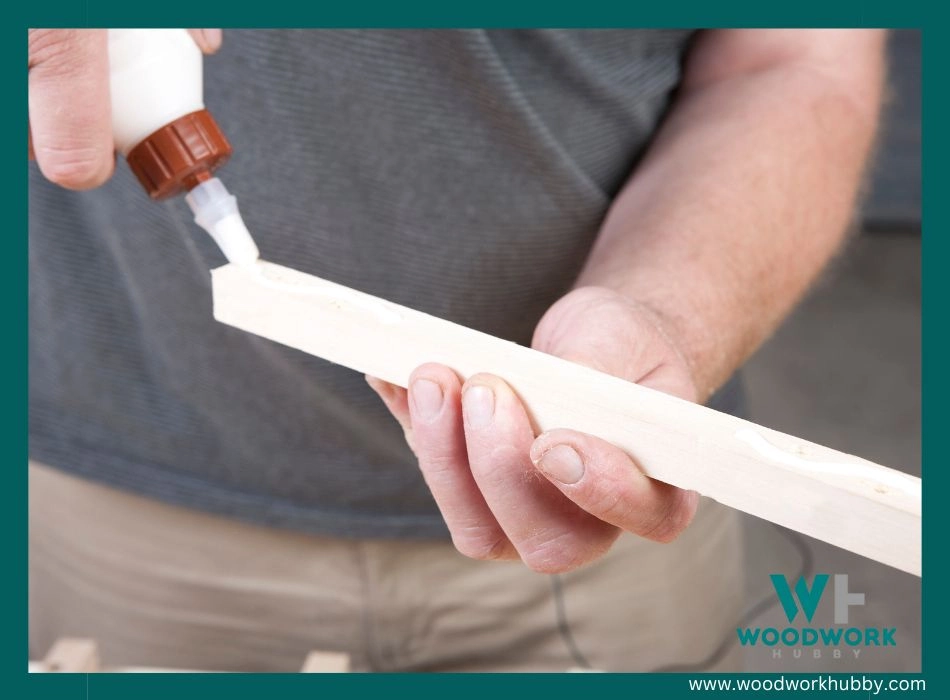
So, if you’re looking for a reliable adhesive for your carpentry or crafting needs, PVA wood glue is definitely worth considering.
FAQs
1. What is the difference between wood glue and PVA?
Wood glue and PVA (polyvinyl acetate) are often used interchangeably, as PVA is a common type of wood glue. However, not all wood glues are PVAs. Other types of wood glues may have different formulations or added ingredients for specific purposes.
2. Can I use any type of wood glue as PVA?
If a wood glue specifically states that it is made with PVA, then yes, you can use it as PVA. However, it’s important to read the label or product description to ensure that the specific type of wood glue you have is suitable for your needs.
3. Are there any advantages to using PVA over other types of wood glues?
PVA has several advantages over other types of wood glues. It has good bonding strength, dries clear, and is easy to clean up with water before it fully cures. Additionally, PVAs are non-toxic when dry and are generally more affordable compared to specialized woodworking adhesives.
4. Can I use PVA for all types of woodworking projects?
PVA can be used for many woodworking projects involving porous materials like solid woods or plywood. However, for projects where exceptional strength or resistance to moisture or heat is required (such as outdoor furniture or structural applications), specialty woodworking adhesives may be recommended instead of or in addition to using PVA-based wood glues.

